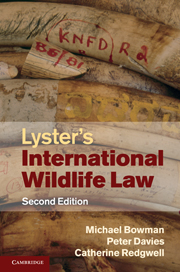Book contents
- Frontmatter
- Contents
- Foreword
- Preface
- List of abbreviations
- PART I Foundations of international wildlife law
- PART II Species regulation
- PART III Regional wildlife regulation
- PART IV Global wildlife regulation
- PART V Biological diversity: a new perspective on wildlife regulation
- PART VI Cross-sectoral issues in wildlife regulation
- 19 Wildlife and trade
- 20 Wildlife and welfare
- 21 Wildlife and pollution
- PART VII Conclusion
- Index
- References
19 - Wildlife and trade
Published online by Cambridge University Press: 05 July 2011
- Frontmatter
- Contents
- Foreword
- Preface
- List of abbreviations
- PART I Foundations of international wildlife law
- PART II Species regulation
- PART III Regional wildlife regulation
- PART IV Global wildlife regulation
- PART V Biological diversity: a new perspective on wildlife regulation
- PART VI Cross-sectoral issues in wildlife regulation
- 19 Wildlife and trade
- 20 Wildlife and welfare
- 21 Wildlife and pollution
- PART VII Conclusion
- Index
- References
Summary
Introduction
Over the past two decades the interrelationship between multilateral environmental agreements (MEAs) containing trade-related environmental measures (TREMs) and trade agreements has received considerable attention. The purpose of this chapter is not to revisit this wider, and well-documented, ‘trade and environment debate’, but rather to locate the international wildlife law and practice discussed here within it. That such treatment is pertinent is obvious given that some of the treaties considered in this volume directly employ TREMs as a regulatory tool. One of the earliest examples is the 1916 Convention for the Protection of Migratory Birds, which prohibited trade in such birds falling within its scope, or in their eggs, during the close season. Today international trade in wildlife is governed primarily by CITES, where the potential for conflict with trade law may arise in consequence of CITES listing. Reeve points out that in 1997 Zimbabwe apparently considered WTO challenge of Appendix I listing of the elephant, to compensate for loss of ivory markets. This course was not taken because CoP 10 downlisted Zimbabwe's elephant population to Appendix II, and permitted limited trade in stockpiled ivory.
Yet the direct nexus with trade does not stop here, as CITES also serves to illustrate. Trade – or, more accurately, suspending trade – may also be employed as a compliance tool. As of 2009 there were thirty-two trade suspensions in effect under CITES, for failure to provide the required annual report on illegal trade, for failure properly to implement CITES in domestic law and for significant trade in Appendix II species.
- Type
- Chapter
- Information
- Lyster's International Wildlife Law , pp. 651 - 671Publisher: Cambridge University PressPrint publication year: 2010



